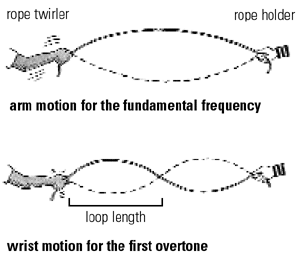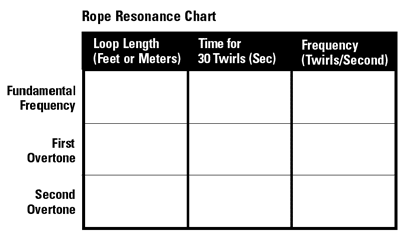The Elegant Universe
|  |
Student Handout
|
A New Building Block?
Some physicists think there is a unit of matter more fundamental than the particles that have so far been detected. They call this new building block a string (named for its string-like appearance). One of the key features of strings is that they generate different vibrational patterns that may give rise to the properties of currently known elementary particles. But how is it possible that elementary particles like electrons and top and bottom quarks—which have different
masses—can be made out of the same thing? Do
this activity to find out.
Procedure
Organize your group into the following roles:
- rope holder
- rope measurer
- rope twirler
- timekeeper
Have the rope holder grip the rope in a fixed
position. For the first trial to determine the
fundamental frequency, have the rope twirler use
the type of arm action used to twirl a jump rope.
Once the rope is twirling smoothly, the measurer should measure and record the loop length. Then the twirler should call, "start," and the timekeeper should use a watch to time 30 twirls. The timekeeper should record this time. The frequency of the rope is defined as the number of twirls per second. Use your calculator to determine this number.
Repeat the above procedure and average the times
for the two trials. This is the Fundamental Frequency. Record the loop length, time for 30 twirls, and
frequency per second in the "Rope Resonance Chart."
Now twirl the rope again, but this time the rope twirler should twirl the rope using his or her wrist only. The twirler should increase the speed of twirling until the large single loop breaks into two opposing loops
turning around a mid-point, called a node. Once the two loops are twirling smoothly, measure the loop length and time 30 twirls as before. Do this twice and average the times. Record this result and the loop length under the First Overtone column.
Repeat this process for a rope that generates three equal loops and record your results in the chart.

Questions
Write your answers on a separate piece of paper.
What happened to the length of a single loop as you twirled faster?
Review your data. What happened to the frequency as you twirled faster?
How did the change in loop length compare to the change in frequency as you twirled faster?
How did your effort change as you twirled faster?
Is there more energy in a higher overtone or a lower overtone? If a fundamental string was like your rope, would there be more energy in a rapidly vibrating string or a slowly vibrating string?
How might a string represent an elementary
particle like an electron differently than a more
massive elementary particle like a top quark?

|

